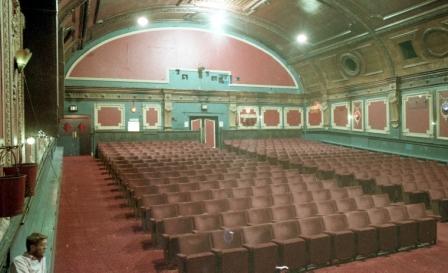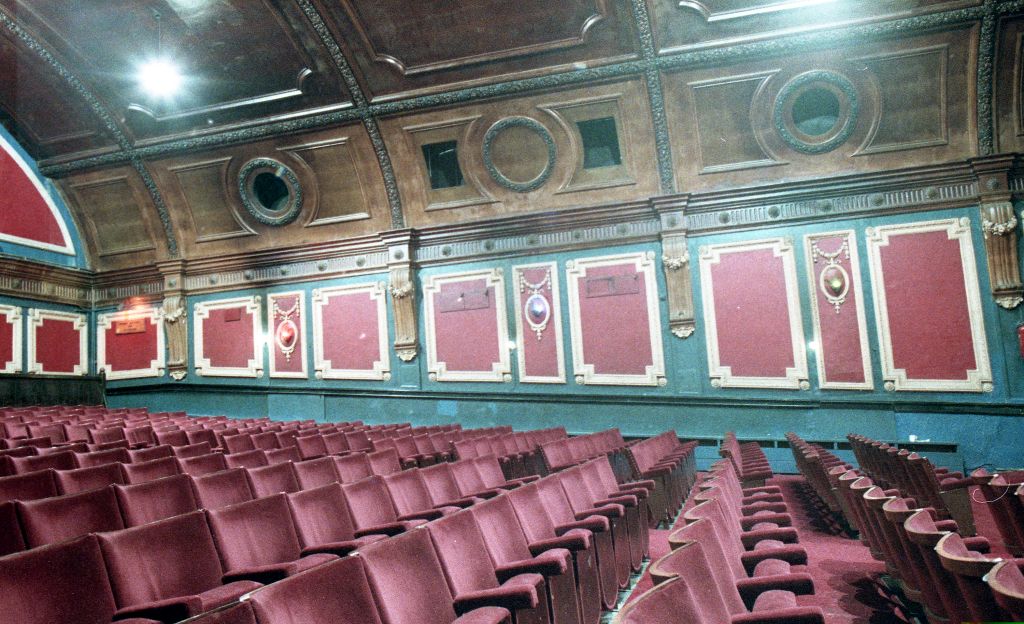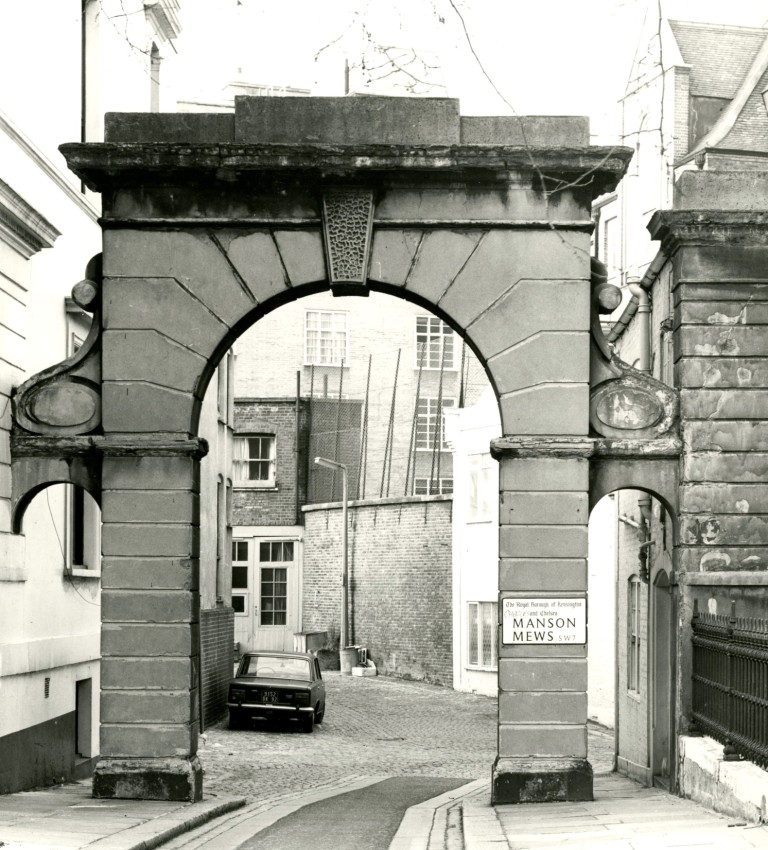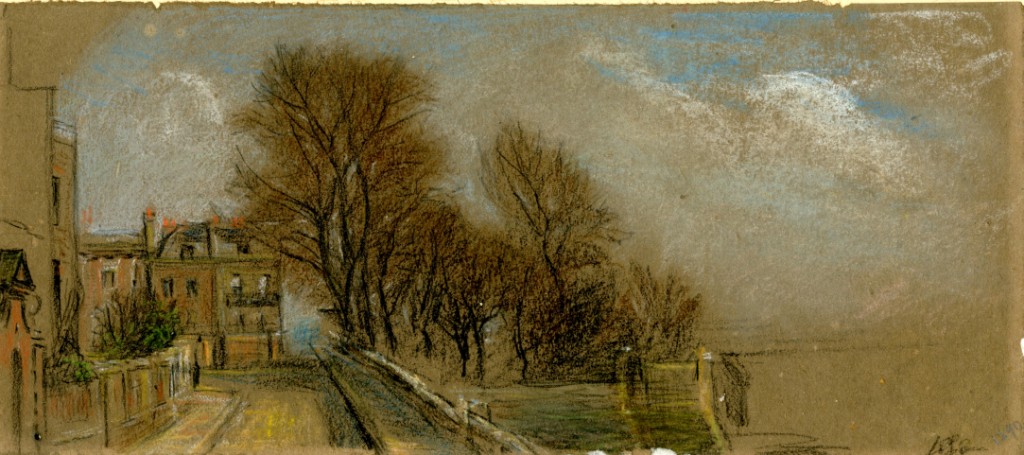I’ve spent the last few days working on a new post. But as I worked I knew that in another room far away from me my friend and colleague Isabel Hernandez was working on the final (?) post in her series on cinemas in Kensington. My efforts naturally have to give way before her magnum opus.
If some cinemas have become relics of the past, then how about a cinema that has survived to become a picture house worthy of its age. For the time being I have decided to conclude my cinema blogs with the Electric Cinema, given we have some excellent photographs to share with you and even if much attention has been paid to this unusually designed building over the years as both saint and sinner in various publications, I thought I would end the subject on a positive note. This one survived the cull, despite the odds, and is now apparently the oldest working cinema in the UK.

There are many in the North Kensington area who will know this building intimately and have come to know ‘the Bug House’, or the ‘Bughole’ as it was sometimes referred to by the local people, as a familiar fixture at 191 Portobello Road.
The Electric Cinema was built by Gerald Seymour Valentin in 1910, on the site of a timber yard owned by Thomas Henry Saunders. It was built in the midst of grocers, butchers, confectioners, decorators, plumbers, cheesemongers, fruiterers…the list is long. You can see the canopies of the many shops stretching right along the street in the image below. It was decided that an entertainment venue was probably a worthy addition in so busy a street.
The cinema opened on the 27th February 1911, although another source states that it was on Christmas Eve, 1910. Perhaps there was a preview? The Electric Cinema is first listed in the 1912 local directory, under the ownership of London and Provincial Cinematograph Ltd.

Valentin was an architect with little to go on as far as cinema building went. There was no exemplary blueprint to fall back on, and the glamorous cinemas of the 1930’s/40’s were yet to be imagined. In 1910 cinema design was still in its infancy and the age of electricity was relatively new. The development of radio, the accessibility of gramophones, and now cinemas, heralded a new era in the world of entertainment. If the industrial age was a significant cornerstone of advancement and prosperity, then technology was a cauldron of possibilities. The British film industry was still very much a new concept. Moreover, the venue was built well before ‘talkies’ became the norm.

It is thought that Valentin built the auditorium with a Music Hall in mind. Geoff Andrew, a former member of staff at the cinema, wrote:
“It was no shock to learn from detailed acoustic analyses carried out in the late Seventies that the auditorium was far more suited to live musical performance than to the reproduction of sound by electric speakers; after all, it was built eighteen years before the introduction of the ‘talkies’, during which period (1910-1929) live piano or band accompaniment would have been used to supply the emotional atmosphere for the moving images on the screen.”
The audience seated in an early image below gives you an idea of how little space there was within the small area. I imagine not as comfortable as the plush cinemas of later years. In fact, nearly all of the cinema space was devoted to the auditorium. It is estimated that the auditorium had the capacity for 600 seats all on one floor.

The cinema met with problems over the course of many years. Its age meant that costly repairs were essential if it was to continue being a viable and safe venue. During the course of the sixties, it was not uncommon to hear about the latest calamitous dysfunction within the building, such as a leaking roof, or a whole row of seats collapsing. It was when new management in 1969 took over that a much-needed refurbishment took place to improve the building – certainly the general condition of the auditorium: the roof was repaired, an efficient heating system was installed, carpets and new seats were bought – it was a welcome change.

The auditorium’s paneling does not appear remarkable in any way in these images. The walls were repainted at some point during the sixties. Some described it as lurid. Aesthetics had to take a backseat to other more important things, like keeping the cinema open and getting paying customers in to watch films as it was intended to do, with enough to make the necessary repairs when the roof or the gutters went awry in inclement weather, which is quite often in the UK, and affected the cinema numerous times. It is important to note that prior to this period the cinema had not been touched in fifty years or so.

Another view of the auditorium. Note the buckets at the back. I describe them as ‘old world’ fire hydrants.

Unlike later, larger cinemas, the frame surround to the screen was relatively simple without a distinctive proscenium arch. Nothing unusual for its time, except the screen remains the same to this day and was never modernised like some of the Electric’s counterparts were over the decades to accommodate CinemaScope – an anamorphic lens series used in the 1950’s and the precursor to the likes of Panavision which allowed for films to be projected at different ratios. I am, of course, only describing this in a very rudimentary way.

Standing enclosure for 27 persons. Not a huge space when you look at the room generally, maximising space sounds like a good idea if you do not mind being in very close proximity to other people, or indeed if you mind standing up. Generally, the community spirit of The Electric gave it a more casual approach to such things. A laid-back acceptance of how it all worked.

Below is an example of that casual atmosphere. Many of the staff at the cinema took great pride in the Electric’s friendly reputation.

Below you can see the dark brown nicotine stained ceiling. Years of tar accumulated over time and yellowed the panels giving them a rather unpleasant, greasy look. It is said that it was at least 1 inch thick. Quite grotesque in retrospect, but not surprising when smoking was usual in public spaces.

During the refurbishment already mentioned, the old projectors were replaced with new projection machines purchased from Winston Churchill’s Chartwell home. After his death they had come onto the market almost new, or so I thought…
Dave Hucker a former manager at the Electric informed me that these particular images show the ‘Italian made Cinemechanicas which were the best projectors in the world at that time and the same at the NFT.’
He goes on to say:
“These date from an upgrade in the mid/late 70s when new seating and a decent screen were installed. This brought the cinema up to a very high standard.”

Enormous machines compared to the digital tech we have now. A fraction of the size.
Also, we cannot fail to look upon these images and not think about a spectre of the Electric’s past, the mass murderer, John Christie of 10, Rillington Place, rumoured to have worked here as a projectionist sometime in the forties. Just one of many stories that are not verifiable, but add a certain mythos to the cinema.

Below you can see the signage of former times. The Electric was renamed The Imperial Playhouse around the period of the First World War, something of a grand title perhaps, but it seems fitting considering the cinema also weathered the Second World War. Initially, there was an order for cinema closures to avoid crowds gathering during the Blitz. A wise precaution. Yet not surprisingly, as London grew more resilient to the raids, cinemas simply carried on. During air raids, an announcement flashed onto the screen and audiences would head out to the nearest shelter, usually collecting a refund on the way out. A very calm attitude considering the circumstances.

The image below shows The Electric in 1977 advertising Wim Wenders’ Kings of the Road. What you may not know is that the cinema, as well as showing some rare classics and notable masterpieces, would often show new films that might perhaps never have seen the light of day, given that distributors were not confident they would do well, so they regularly shelved them. In fact, directors as varying in their styles as their eras, received their first British releases at the Electric. Directors such as Orson Wells, Fritz Lang, Martin Scorsese, and John Huston. Hard to believe, but when you are starting out, or simply trying to establish yourself outside of your usual base, it isn’t always plain sailing, and it wasn’t initially for these now well-known auteurs. Creative efforts are so often thwarted, and talent is a mixed bag of luck, hard work and vision. Everybody starts at the beginning somewhere.

Double bills were part and parcel of the Electric experience in its varying incarnations. Films would be programmed together because of their similarities and it offered customers value for money. Geoff Andrew states that:
“The juxtaposition of two films can throw up interesting ideas by means of the films’ similarities and differences. For instance, in a season of movies dealing with madness, we doubled Hitchcock’s famous Psycho with John Huston’s film Freud. Or Pontecorvo’s Battle of Algiers with the Marx Brothers’ Duck Soup which offers a far less dark but in its way equally cynical view of political machinations.”
I don’t see that level of thought going into the general cinematic experience currently, with some exceptions, like The Prince Charles in the West End.

My husband’s programme, Shock Around the Clock, which he has kept over the years. A precursor to the continuing successful horror film festival, Frightfest. Over a period of 12 hours one would sit and watch several films back-to-back. No mean feat, as personally, I probably would have died from a migraine the size of a planet. But it shows the dedication of some film buffs and those organisers willing to go the extra mile.

The Texas Chainsaw Massacre apparently made its first run in uncut form at the Electric cinema. Although the cover you see is from the third instalment. Below a list of what was shown.

Programme booklet credits.

As with most cinemas the spectre of closure loomed over The Electric too. And it did close in May 1987 after staff, local residents and celebrities campaigned in vain to keep it open, despite efforts over several years to return the cinema to its former glory under different ownership. Mainline Pictures who took over in 1987 renovated the building and brought the cinema up to scratch, rebranding it the Electric Screen. This was no bad thing; The Electric desperately needed a facelift. Or did it? As with most information the truth can sometimes be a little stretched or simply incorrect. Dave Hucker, former manager at the Electric, points out that this was one of many myths surrounding the cinema. Unfortunately, programming was also changed, and regulars began to stay away. Changing from repertory to single-run programming proved too much of a change, altering the cinema’s personality, if such personification can be allowed here. What made it unique had been altered to the point where revenue began to fall. Whatever the reasons, as it stood, it could no longer compete with West End arthouse cinemas, even as a second-run rep house.

The cinema entrance below. Interestingly, in 1938 plans were submitted detailing a proposed alteration to The Imperial Playhouse as the Electric was then. Had this been carried out, the façade of the building would have been radically transformed, making it look more like a Thirties art deco building. The dome was going to be removed completely and a permanent canopy above the entrance was to be erected, which sounds intriguing. In the end none of it came to fruition, I suspect due to a lack of money. Austerity during the war years halted a lot of ideas.

Below you can see the tiled floor in more detail at the entrance..

The doors leading into the auditorium.

The box office which reminds me of fair grounds for some reason. The place where you could purchase reasonably priced tickets and enjoy the inexpensive programming. Alas! No popcorn anywhere!

The Electric is currently owned by retail entrepreneur Peter Simon who was once a local trader. He invested a considerable amount in the restoration of parts of the cinema before leasing the site to Soho House.
Below is an image of what The Electric looks like today.
Gebler Tooth Architects took on the job using the original plans and any early photographs that were available:
“We’ve restored all the mouldings in the auditorium. The High-level mouldings just needed washing. It was hard to determine what colour the auditorium was painted in the first place. We’ve gone for an ivory background with mouldings and the gilding left but washed.”
They wisely acquired the shop next door and expanded the space for upgraded WC’s, an air conditioning plant, and a restaurant.
Gone are the days of the affordable fleapit. Lamentably money keeps things ticking over until it doesn’t. Without it closures happen. I say lamentably because it shows up the inequalities within communities. Not everybody can afford the changes.

Portobello Road, taken from the roof of The Electric in the 1980s before the wave of tourists took over chasing after the Notting Hill dream. Sitting on a 52 bus I have often been asked by visitors if this was the correct transportation to take them to Portobello. The Portobello of Hugh Grant, Julia Roberts, a big blue door and celebrity. Prior to that, Portobello Road was a Disney song in Bedknobs and Broomsticks.
And don’t forget Paddington Bear, although his claim is far more established in my opinion, as his creator lived in the area.
As a child, Portobello Road was nowhere near as glamorous as it is now portrayed on the big screen. It was the place where you went to get your fruit and veg, settled down for a cup of tea in some greasy spoon café. And if you fancied some entertainment, perhaps an obscure double bill over at the eccentric and unique 191 Portobello Road after a couple of drinks at the local pub.
For me it was Spanish School twice a week down the other end of Portobello after Secondary school, and the occasional visit to Garcia’s with mum for chorizo and bacalao. And sometimes, when I later worked in the area, it was the occasional lunch for a take-away from any one of the many options along Portobello Road. Over the decades I have noticed its gentrification. Now it’s so different I almost think I imagined what it was like before. I suspect the same can be said of our changing city and its buildings generally. But Portobello will always be Portobello and perhaps its historic cinema too will remain so. It has survived this long, we shall see.

Postscript:
It has taken me an eternity to finish this blog, not because it was particularly difficult, but because so much has happened in recent months, both personally and otherwise. I kept shelving it, not really having the time to complete it. Getting around to finishing this proved challenging, but I am grateful that I have been able to do so. Also, I realise that The Electric Cinema is well known in the area and as an iconic cinema much has been written about it. I tried to keep things succinct as far as possible and have probably not covered everything. Everyone has a wealth of memories regarding the past – an impossible task for a blog. But I hope you have enjoyed it and allowed for some escapism from the isolation. At this point many of us will be re-evaluating life and some of us will be struggling with the fallout of this for various reasons.
We live in very strange times indeed, and perhaps we are on the threshold of drastic changes given how our lives appear to have been turned upside down. I’m not sure what to make of it as the everyday now seems not so normal. And we wonder what was normal to begin with. The things we once thought were important are now in question.
Please look after yourselves and take good care. Look out for each other and help where you can. We will endeavour to keep you posted where possible and continue to offer a virtual service for Local enquiries.
Postscript to the postscript
My thanks to Isabel, and to her husband Paul (who added some personal knowlege) for this excellent post. Also to the many people who worked at the Electric and those who have donated material to the collection.
Dave.





















































































































































